
As a healthcare worker, you know just how important good hand hygiene is. No matter whether you’re an NP or a PT, you know that failing to clean your hands properly could have potentially serious consequences for your patients’ safety. The problem is that there are a lot of handcleaning techniques out there, and far too many of them either gloss over or completely skip crucial steps in the sanitizing process.
To help you cut through the noise, we talked to the experts at the Centers for Disease Control and Prevention (CDC) to get their take on proper hand hygiene techniques.
According to the CDC, proper hand hygiene refers to the methods used to remove or kill bacteria on hands. It recommends two methods for routine handcleaning: handwashing with soap and water or hand antisepsis using an alcohol-based hand rub.
The CDC says that hand antisepsis is the preferred hand hygiene method in most clinical situations. However, handwashing should be performed whenever your hands become visibly soiled or you may have been exposed to spores. Why? Spores may not be killed or removed by alcohol-based hand rubs. C. difficile is an example of a diarrheal illness caused by spores.
To be most effective, alcohol-based hand rubs should have 60 to 95 percent alcohol. If you’re washing your hands, you may use antimicrobial soap, but this is not recommended over plain soap.
The CDC provided us with the following list of scenarios for when you should either perform hand antisepsis or wash your hands.
The World Health Organization (WHO) created a nine-step process for safe handwashing. The steps are as follows:
If you want to learn more about the proper techniques for handwashing, or how to prevent your hands from drying out, take a look at our article, "The Proper Handwashing Procedure for Nurses."
When applying hand sanitizer, make sure to take the following steps:
The CDC provided us with a few extra tips for maintaining proper hand hygiene:
Originally published on July 6, 2018.
Updated on March 8, 2020.
Image courtesy of iStock.com/Mladen Zivkovic
Last updated on Jul 24, 2024.
Originally published on Mar 09, 2020.
More:
The views expressed in this article are those of the author and do not necessarily reflect those of Berxi™ or Berkshire Hathaway Specialty Insurance Company. This article (subject to change without notice) is for informational purposes only, and does not constitute professional advice. Click here to read our full disclaimer
The product descriptions provided here are only brief summaries and may be changed without notice. The full coverage terms and details, including limitations and exclusions, are contained in the insurance policy. If you have questions about coverage available under our plans, please review the policy or contact us at 833-242-3794 or support@berxi.com. “20% savings” is based on industry pricing averages.
Berxi™ is a part of Berkshire Hathaway Specialty Insurance (BHSI). Insurance products are distributed through Berkshire Hathaway Global Insurance Services, California License # 0K09397. BHSI is part of Berkshire Hathaway’s National Indemnity group of insurance companies, consisting of National Indemnity and its affiliates, which hold financial strength ratings of A++ from AM Best and AA+ from Standard & Poor’s. The rating scales can be found at www.ambest.com and www.standardandpoors.com, respectively.
No warranty, guarantee, or representation, either expressed or implied, is made as to the correctness, accuracy, completeness, adequacy, or sufficiency of any representation or information. Any opinions expressed herein are subject to change without notice.
The information on this web site is not intended or implied to be a substitute for professional medical advice, diagnosis or treatment, and does not purport to establish a standard of care under any circumstances. All content, including text, graphics, images and information, contained on or available through this web site is for general information purposes only based upon the information available at the time of presentation, and does not constitute medical, legal, regulatory, compliance, financial, professional, or any other advice.
BHSI makes no representation and assumes no responsibility or liability for the accuracy of information contained on or available through this web site, and such information is subject to change without notice. You are encouraged to consider and confirm any information obtained from or through this web site with other sources, and review all information regarding any medical condition or treatment with your physician or medical care provider. NEVER DISREGARD PROFESSIONAL MEDICAL ADVICE OR DELAY SEEKING MEDICAL TREATMENT BECAUSE OF SOMETHING THAT YOU HAVE READ ON OR ACCESSED THROUGH THIS WEB SITE.
BHSI is not a medical organization, and does not recommend, endorse or make any representation about the efficacy, appropriateness or suitability of any specific tests, products, procedures, treatments, services, opinions, health care providers or other information contained on or available through this web site. BHSI IS NOT RESPONSIBLE FOR, AND EXPRESSLY DISCLAIMS ALL LIABILITY FOR, ANY ADVICE, COURSE OF TREATMENT, DIAGNOSIS OR ANY OTHER SERVICES OR PRODUCTS THAT YOU OBTAIN AFTER REVIEWING THIS WEB SITE.
Click to collapse disclamerWant Berxi articles delivered straight to your inbox? Sign up for our monthly newsletter below!
"*" indicates required fields